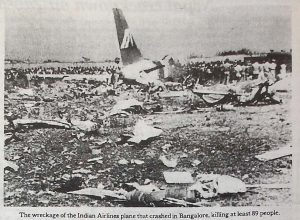BANGALORE: Eighty nine people were killed when an Indian Airlines airbus crashed seconds before landing at the Bangalore airport in Karnataka Feb 14,
Fifty seven passengers had a providential escape.
Airlines sources said 17 foreigners were traveling in the plane.
The AB-320 caught fire on crashing and several bodies of several victims were burnt beyond recognition.
The flight, which was on a Bombay-Bangalore flight, had 146 passengers and crew on board,
The plane which crashed at 1215 hrs local time, hit the embankment of a dried lake about 300 meters from the runway.
One of the victims included noted industrialist Ashok Vardman Birla who was to inaugurate a factory here.
The survivors included two air hostesses who had opened the backdoor and helped some of the passengers to escape.
Ms. Neela Sawanth, one of the air hostesses who opened the aircraft door, refused to recall the incident saying,
“I want to forget it.” Twenty seven injured passengers were admitted at the HAL hospital and 27 at the air-force hospital.
One the survivors, an American passenger Charles Mancosky, said “‘we heard a loud booming noise and soon we were enveloped in a ball of flame.”
Mancosky said he first thought it was a “hard landing” but soon heard a bang.
Of the 139 passengers, 101 were male, 29 female, five children below 12 years and four infants below two years.
Captain S.S. Gopujkar, who piloted the aircraft, had logged 10,300 hours flying experience by January 31 while co-pilot C.A. Fernandes had 9,300 hours flying experience.
Captain Gopujkar was an instructor on Boeing 737 and check pilot on A-320 aircraft.
The plane, an Airbus 320 delivered to the national domestic carrier on Dec 24, 1989 was carrying 135 passengers, 4 additional passengers who infants were not assigned seats and a crew of 7, an airline spokesman here said. It was about to land after a flight from Bombay when it undershot the Runway in Bangalore by about 1,000 feet just after noon, under clear skies. It hit an empty reservoir.
When the final death toll is known, the crash could be nearly as high as an Indian Airlines accident on Oct 19, 1988 in the western city of Ahmadabad that killed 133 people. That crash, involving an old Boeing 737, was apparently caused by pilot error. On the same day, a small Fokker Friendship plane belonging to the feeder airline Vayudoot also crashed in the Indian northeast, killing 34 people.
The accident came as India’s domestic airline, which has a virtual monopoly on internal flights, is under intense criticism and strain, unable to meet the needs of at least 30,000 travelers daily.
Planes often fly 18 hour days with multiple take offs and landings. Delays and cancellations along with the worst cabin service in Asia outside China and Vietnam have become legendary. Strikes walkouts and the occasional sit down protest by enraged passengers have added to the airline’s problems.
In 1988, when the first of the Airbus 320’s built by a European consortium, were about to be delivered to India, pilots at Indian Airlines threatened to refuse to fly them, saying the sophisticated planes could not be properly maintained in India.
Engineers later went on strike demanding to be sent to. France to be trained to look after the planes, whose operations Indians describe as “‘fly by wire.”
Nineteen of the planes were purchased in 1986 and additional orders were made later. As they began to enter Indian Airlines service, they encountered peculiar local conditions: dust, severe monsoon rains and flocks of vultures that live on illegal trash dumps and slums that have encroached on airport lands.
The Airbus 320 the plane that crashed during the Paris air show in June 1988, has such advanced computer technology that Indian aviation experts questioned whether it would deprive pilots of the power of quick response in an emergency.
India has seen a series of bizarre accidents over the last several years, including one in which pilots forgot to lower the plane’s wheels and another in which the plane hit a wandering bull crossing the runway. Crews have flown on the authorization of unqualified examiners. Passengers have sacked airline offices or commandeered planes.
Indian airports have outdated equipment, forcing long delays and unannounced rerouting in fog or heavy rain. Ground staff members are often careless. Hardly anyone traveling in India is without stories of near disaster in the skies or unbelievable management on the ground.
On a flight in October from New Delhi to Goa, an aircraft was more than an hour late taking off because someone had parked another plane too close behind it, and to start the engine of the first aircraft would have destroyed the second, the pilot said. Passengers had to wait for a change of shift when someone would be authorized to move the other aircraft.
India’s growing consumer movement, led by the Common. Cause organization, and the new Minister of Civil Aviation, Arif Mohammed Khan, have tried to force the airline to improve services. Mr. Khan recently announced that cabin crews, whose sloppy service is notorious, would be retrained by a team from the Scandinavian Airlines System.
Mr. Khan, who took office in December, has tried to introduce telephone information on flight schedules. But when he made an unannounced check at Delhi airport one morning, he found most of the numbers out of order within days of their installation.

Article extracted from this publication >> February 23, 1990